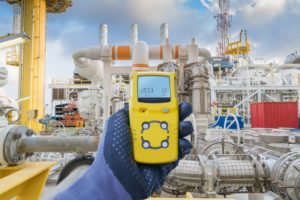
Gas detectors play an important role in the safety of a work environment. Able to detect harmful gases in a certain area, they can alert the operator to unsafe conditions, allowing the people to leave until the situation is resolved. Also, if you’re looking to fix the leak, a portable gas detection monitor is what you would use to find the source so it can be dealt with. Here are some of the basics of gas detectors.
Detecting Toxic Gases
There are two principal types of portable gas detectors: combustible and toxic. The most common means of detecting toxic gases is through electrochemical sensors. Functioning via electrode signals, they’re usually most effective detecting gases such as carbon monoxide, chlorine, and nitrogen oxides. Another popular type of toxic gas detector is the metal oxide semiconductor – or MOS – style of detector. Using a sensitive film composed of tin or tungsten oxides, the film reacts to the hazardous gas (usually carbon monoxide), setting off alarms.
Detecting Combustible Gases
A large number of portable gas detectors that are designed to sense combustible gases use infrared sensors which operate a system of transmitters and receivers. When a gas (hydrocarbon vapors) interferes with the transmission of the infrared light, the detector will notify the operator.
Common Uses
Though portable gas detection monitors are common in many types of industries, they are mostly used in an industrial capacity. They protect workers in welding shops whenever combustible gases become present, as well as nuclear plants as a protection against combustibles. Wastewater treatment plants rely on detectors to notify employees if there are any hazardous gases in the area. Portable detectors are particular helpful when a leak may be present in a confined areas where workers are less likely to frequent.
Calibration
To keep sensors operating at peak efficiency and accuracy, they must be calibrated regularly. As part of the regular maintenance process, calibration ensures that the monitor is reading the correct level of gas. Portable detectors are exposed to a wide variety of environments, and must be calibrated more frequently than standing sensors.
It’s crucial that sensors be properly maintained. A contaminated sensor can misread gas levels, with hazardous results.






